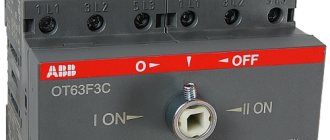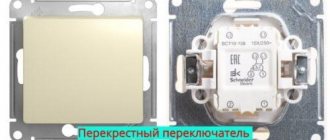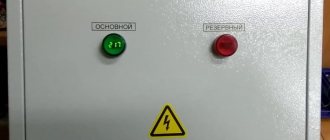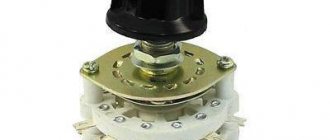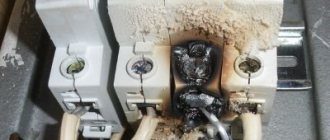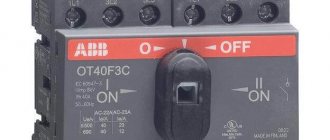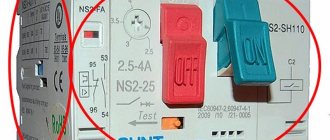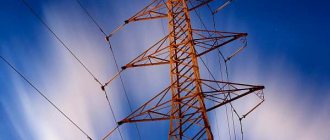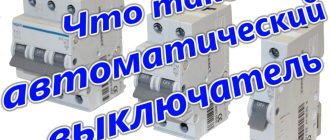5 / 5 ( 1 voice )
A reversing switch or switch in household electrical networks is usually used to connect backup power. These can be gasoline and diesel generators, as well as, for example, connecting a second source of electricity from another power line for reliable power supply to a private home. Switching is done mechanically in manual mode, do not confuse it with ATS (automatic transfer switching).
Because I mainly assemble electrical panels using ABB components, and I also use their reversible changeover switch. But it happens that I also install other switches, for example, “manual reserve input” from Legrand and SFT breaker switches from Hager, but I will write about this in separate articles.
When assembling electrical panels, I use ABB reversing load switches of 40A or 63A, depending on the power allocated for connecting a private house. There are also smaller ratings of 16 and 25 A, but they are very small and inconvenient to make switches with. To be honest, I don’t even know where they are used.
Often, when ordering electrical panels, you ask why you need to install a reversing switch , why you can’t just install a machine for the generator. The answer is very simple:
- Do not supply voltage to the general network , i.e. so that your generator does not become a source of electricity for the entire common power line. The neighbors, of course, will be happy with the electricity they receive from you, but at this time they may be fixing an accident on the line, and the electricians will come under voltage.
- The load transfer switch eliminates the possibility of back-to-back connection of two power sources , the main power supply from the power line and the backup one from the generator. The reversing switch eliminates the possibility of supplying voltage to the general network, or
Of course, theoretically, you can turn off the input circuit breaker or switch yourself, turn on your generator and use electricity from the generator. But who will give a 100% guarantee that one day you will not forget to turn off the input? Nobody, but as I wrote above, the reversing switch eliminates this. In simple words, this is “fool protection” .
The reversing switch has three positions:
- I ON – the left pole of the switch is on, while the right pole is off.
- О OFF – everything is disabled (both inputs).
- II ON – the right pole of the switch is turned on, while the left one is turned off.
The connection diagram for a backup generator to a changeover switch has several options depending on how many phases the generator is designed for. It also matters how many phases in the electrical panel at home you want to connect to the backup input.
Inverter system as a backup power source
The electrical system operates in fully automatic mode, eliminating the need for human presence. The principle of operation of inverters in basic and advanced configurations is the same.
When there is voltage in the network, the inverter passes it through to the load and maintains a charge in the batteries. As soon as the basic power supply from the grid is interrupted, the inverter takes energy from a backup source, that is, directly from the energy storage device.
In this case, the direct current of the battery is converted by the device into alternating current with a pure sine voltage of 220 V, ideal for operating even the most demanding electrical appliances. This transition is carried out instantly, so devices connected to the network continue to operate normally from a backup power source.
The number of inverters and storage devices directly depends on how long the backup power source must be used and how much power it must provide for electrical appliances. The battery charge may be enough to keep existing devices in operation from several hours to several days.
Inverter backup power supply systems
The best option for solving the problem of interruptions or lack of electricity are PremiumVolt and PracticVolt inverter backup power supply systems based on professional inverters/chargers OutBack Power (manufacturer - USA) or Victron Energy (Netherlands) and special high-capacity batteries (energy storage devices).
Depending on user requirements, the number of system components may vary. Thus, to service individual strategically important devices (for example, a gas boiler, a computer or refrigerator, medical or commercial equipment, etc.), one inverter and a pair of batteries are sufficient.
To provide backup power to an entire building, a more powerful inverter is used, or the system’s power is increased by simultaneously connecting up to ten voltage converters. At the same time, the number of drives in the system needs to be increased.
To ensure long-term autonomous operation, a generator, solar panels and a wind generator can be used as part of an inverter system.
Each system is selected individually. Call us or send a request from the website for a free system selection.
Advantages of inverter uninterruptible power supply systems
| Automatic operating mode | Resistance to double overload | Instant guaranteed switching to inverter backup power |
| Generates quality output voltage with pure sine wave | Operates automatically as a backup power source | Can act in combination with alternative energy sources |
| High reliability based on advanced technologies | They have the function of adding power to the power of the network or generator | Provide uninterrupted power supply to the home without the formation of exhaust gases and noise |
Read also: Car compressor does not turn on
Full description
The automatic transfer input device is designed for automatic transition to the reserve input in alternating current networks with a frequency of 50 Hz. It is used in industrial, commercial and domestic facilities, as well as in residential buildings.
The AVR automatic transfer device belongs to the class of new generation products.
The product includes a digital control unit - controller, which ensures high reliability, energy savings, compactness and ease of use.
The device has a mechanical lock, which makes the operation of consumers connected to the device absolutely safe.
The line switching function is provided by rotating an electric motor that drives the circuit breaker arms.
